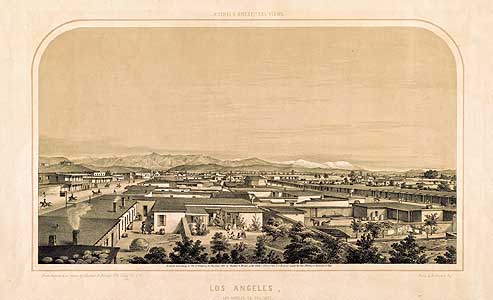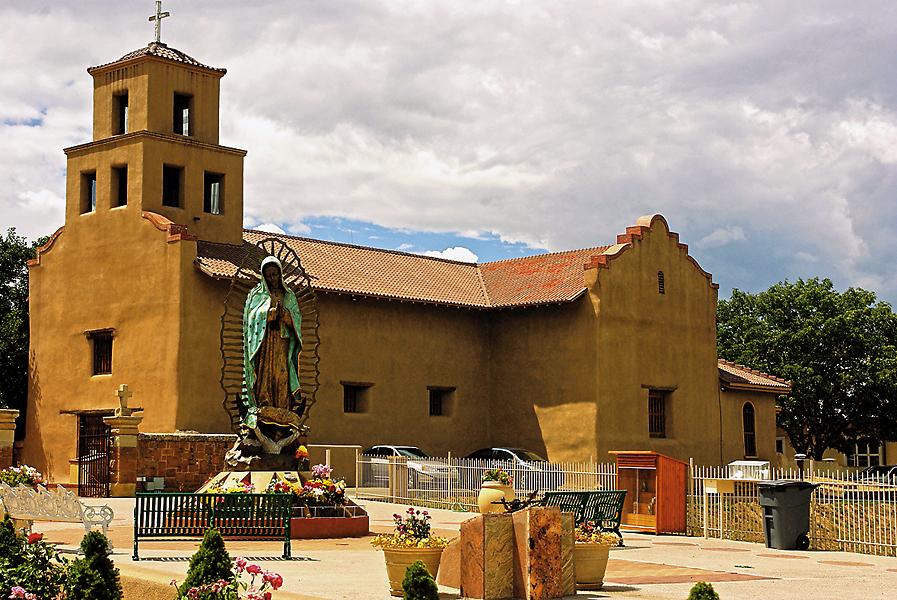 Unlike the Santa Fe or Oregon Trails, you won’t find any trail ruts on the Old Spanish Trail. For that matter, it’s even hard to find tapas restaurants.
Unlike the Santa Fe or Oregon Trails, you won’t find any trail ruts on the Old Spanish Trail. For that matter, it’s even hard to find tapas restaurants.
Historian Rod Miller points out that the trail isn’t old, and isn’t Spanish, and LeRoy R. and Anne W. Hafen wrote in Old Spanish Trail: Santa Fe to Los Angeles: “The Old Spanish Trail was the longest, crookedest, most arduous pack mule route in the history of America.”
Even today, the Old Spanish Trail is arduous (especially during rush hour in Las Vegas and Los Angeles), long and crooked. But for pure Western scenery and a great look at the American West—then and now—this is one trail worth following.
The question, of course, is which route to take. America’s 15th National Historic Trail has three routes, all beginning in Santa Fe, New Mexico, and ending in Los Angeles.
The North Branch takes travelers through Taos and into Colorado (Saguache, Grand Junction), then across central and southern Utah, sliding through southern Nevada and into California. The Main Route heads to Durango, Colorado, and Moab, Utah, before picking up the North Branch trail in Green River, Utah.
I’ve elected the Armijo Route for good reasons. Okay, number one is my choice because it’s shorter than the others, but I am also a historical purist, and Antonio Armijo’s route came first. Besides, the Armijo route goes through Page, Arizona, where the margaritas at Fiesta Mexicana are just slightly smaller than Lake Powell in a wet year.
Late in 1829, Armijo, a Santa Fe merchant, left New Mexico with men, mules and—most important—goodies to sell. By the end of January 1830, they had reached San Gabriel Mission. Goods were exchanged, and the trade route between Santa Fe and L.A. was open.
Santa Fe
One of America’s most popular tourist destinations, Santa Fe is a great place to begin this journey because here, neither heritage nor culture has been forgotten.
Start at the New Mexico History Museum and Palace of the Governors for a 400-year history lesson. That complex is just off the historic Plaza, and the Plaza is a shopper’s paradise. Remember: The Old Spanish Trail was about trading and spending money, and Santa Fe is always about spending money. This is true especially during Traditional Spanish Market (and its companion, Contemporary Hispanic Market), held on the Plaza in July.
But the city’s also about history and art, and the Museum of Spanish Colonial Art, the Museum of Indian Arts and Culture and the Museum of International Folk Art on Museum Hill are also
worth visiting.
Yet the best place to experience the Old Spanish Trail is at El Rancho de las Golondrinas, a living history museum that preserves the Spanish Colonial and Territorial period of New Mexico. The site was an original stop on the Camino Real and is host to a number of festivals, celebrations and history events each year.
Santa Fe might be an art mecca (Gib Singleton, Georgia O’Keeffe), but the West lives here. Hey, cowboys have been saddling up for June’s annual Rodeo de Santa Fe since 1949.
Finally, if you love tapas, Santa Fe has plenty of “small bites.” Check out Taberna la Boca, El Meson Restaurante or El Farol before heading north.
New Mexico
Armijo began his journey from Abiquiú on November 7, 1829. These days, Abiquiú is better remembered for O’Keeffe’s paintings and the scenic Chama River, but 15 miles north you’ll find Ghost Ranch Piedra Lumbre Education and Visitor Center, which contains exhibits on the Old Spanish Trail—as well as geology, paleontology, archeology and other cultural and historical exhibits.
After that, leave O’Keeffe country for Tony Hillerman terrain and the Navajo Nation. Armijo found a Navajo settlement on his journey west. On his return to Santa Fe in the spring of 1830, he reported that Navajos stole some of
his animals.
Aztec is worth a stop for Aztec Ruins National Monument, which preserves kivas and other structures of Ancestral Pueblo people (we don’t call them Anasazi these days) from the 1100s through 1200s.
And if you like fly-fishing, the San Juan River is a pretty good place to wet a fly.
Speaking of the San Juan, Armijo crossed the river twice, first near Blanco, and then near the mouth of the Mancos River in the Four Corners area. It is unlikely that Armijo and his mules stopped for a “photo op,” but since you’re in the neighborhood, you might as well be a complete tourist at Four Corners Monument and stand at the reputed intersection of Arizona, New Mexico, Utah and Colorado.
Arizona
After crossing the Arizona border, check out the trading post at Teec Nos Pos (pronounced Tease-Nhas-phas), established in 1905 and still carrying an extensive collection of Navajo rugs.
Armijo continued west, passing Church Rock near Kayenta, but once you reach Kayenta, you should take a detour. After all, how close do you actually get to John Ford Country? Head north into Utah and visit Monument Valley, where John Ford—and other directors—turned out some spectacular Western movies (and some garbage, too, but always beautiful to look at).
While in the neighborhood, spend a while at Goosenecks State Park. You’ll likely be tempted to keep on north to Moab and Arches and Canyonlands National Parks, but, trust me, there’s a lot to see on Armijo’s route.
Navajo National Monument, Antelope Canyon, Horseshoe Bend, historic Lees Ferry and Lake Powell are just a few of my favorites. Page is a good base camp to check out those sites. While in Powell, drop in at Page’s only history museum, the Powell Museum, to learn about another courageous explorer, Colorado River rat and trailblazer, John Wesley Powell.
Utah
Once in Utah, you should be prepared to make more deviations: Glen Canyon National Recreation Area, Grand Staircase Escalante National Monument, Bryce Canyon National Park, Coral Pink Sand Dunes State Park, Zion National Park, Cedar Breaks National Monument, even back into Arizona at Grand Canyon National Park’s North Rim and Pipe Spring National Monument.
The country’s spectacular, but it had to have been incredibly harsh for a mule train in the winter of 1829. After all, Armijo couldn’t break up his travels to learn about paleontology and geology at Big Water Visitor Center in Big Water, Utah, or the Ancient Ones at Red Pueblo Heritage Park and Anasazi Museum in Fredonia, Arizona.
Eventually, you’ll wind up back in civilization at St. George, Utah, where you can get your art fix (St. George Art Museum and Store) and history lesson (Daughters of the Utah Pioneers). Okay, I doubt if you’ll find any authentic tapas in town, but the view and chow at the Riverwalk Grill is hard to beat.
Nevada
In Nevada, the country becomes really dismal. And hot.
Southern Nevada can surprise travelers, though, as in the case of Valley of Fire State Park, a red-sandstone haven for rock climbers and people who like to sweat in the summer. The park was founded in 1935, the same year the Lost City Museum was built in nearby Overton by the National Park Service.
When you reach Las Vegas, give the casinos and shows a break and check out the views at Red Rock Canyon National Conservation Area, learn the region’s history at Clark County Museum in Henderson, and marvel at Hoover Dam near Boulder City.
Las Vegas was on Armijo’s route too. He followed a shortcut across the Mojave Desert that Rafael Rivera had discovered in 1828 or 1829—Indians, of course, knew of it long before.
Las Vegas, or “The Meadows,” became a watering hole on the Spanish Trail for the next two decades, and Old Las Vegas Mormon Fort State Historic Park is worth a look. There’s no neon here to burn your retinas, just the ruins of an old adobe fort.
Then it’s across the Mojave Desert and into California.
California
The land’s still brutal in the Mojave, but the food today’s better than it was when Armijo was trying to make a living.
His diary entries for January 1830 say much in few words:
17. A day’s journey without water.
20. A day’s journey without water.
23. Along this same arroyo; we ate a horse.
24. Ditto.
25. Ditto.
26. Ditto; we ate a male mule belonging to Miguel Valdés.
Just north of Barstow, stretch your legs at Calico Ghost Town. It’s touristy and overpriced, but give Knott’s Berry Farm credit for preserving this 1880s silver camp.
Then pick up the Old Spanish Trail history at Barstow, where the trail is featured as part of the Barstow Main Street Mural. The Mojave River Valley Museum preserves the valley’s scientific, cultural and historical heritage.
By January 27, 1829, Armijo’s men had reached the San Bernardino canyon and were in San Jose on January 29 at San Gabriel Mission on January 31.
You’ll notice an increase in traffic along the freeways, but maybe not so many tourists at the Agua Mansa Pioneer Cemetery, a state historical landmark, in Colton near San Bernardino. Mission San Gabriel Arcángel, of course, is a must stop for Old Spanish Trail buffs.
San Gabriel, which celebrates its 243rd Fiesta de San Gabriel on August 29-31, is the birthplace of the Los Angeles region, and our final stop.
Silent film star William S. Hart never made any movies about the Old Spanish Trail (he left that to Roy Rogers and On the Old Spanish Trail in 1947), but the William S. Hart Ranch and Museum in Newhall is a well-preserved look at how a Hollywood cowboy was living in the early 1900s.
Other area museums reveal just how much L.A. has to offer, from the George C. Page Museum and the La Brea Tar Pits to the Autry National Center (Gene Autry’s museums are certainly better than his movies), Natural History Museum of Los Angeles, Travel Town Museum and Forest Lawn Museum.
Our trail ends at the Los Angeles Plaza Historic District, a.k.a. El Pueblo de Los Angeles State Historic Park. L.A.’s oldest section—El Pueblo de la Reina de Los Angeles—was the community center during the rule of the Spanish (1781-1821), Mexican (1821-1847) and United States (after 1847). Designated a state historic monument in 1953, it was added to the National Register of Historic Places in 1972.
I’m hungry. This being L.A., I’m certain I can find tapas somewhere near here. I haven’t had any since Santa Fe.
Johnny D. Boggs recommends, no matter which route you take, checking out the Old Spanish Trail Association (OldSpanishTrail.org) for travel and history tips.
Photo Gallery
– All Photos By Johnny D. Boggs unlees otherwise noted –
– Courtesy Library of Congress, Kuchel & Dresel, lithographer, print by Britton & Rey, circa 1857 –















